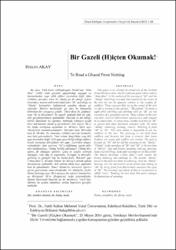| dc.contributor.author | Akay, Hasan | |
| dc.date.accessioned | 2021-07-09T12:12:40Z | |
| dc.date.available | 2021-07-09T12:12:40Z | |
| dc.date.issued | 2015 | en_US |
| dc.identifier.citation | AKAY, Hasan. "Bir Gazeli (H)içten Okumak!". Divan Edebiyatı Araştırmaları Dergisi, 14 (2015): 1-28. | en_US |
| dc.identifier.uri | http://www.devdergisi.com/DergiTamDetay.aspx?ID=220 | |
| dc.identifier.uri | https://hdl.handle.net/11352/3759 | |
| dc.description.abstract | Bu yazı, Türk divan edebiyatı şairi Necâtî’nin “döne
döne” redifli ünlü gazelini yapısalcılığa yapışan zıt
kavramlardan veya zıtlık çiftleri üzerinden değil, fakat
zıtlıkları yerinden eden bir dönüş ya da döngü eylemi
üzerinden, metnin mihverini teşkil eden “âh” yolculuğu ve
“dönüş” kavramları bağlamında yeniden okuma girişimidir.
Metnin merkezinde yer alan bu kavramlar
birbirinin bir versiyonu gibidir. ‘Döne döne âh çekilmesi’
veya ‘âh ile dönülmesi’; bu sayede maksadı belli bir eylemin
gerçekleştirilmesi şeklindedir. Metinde ve ait olduğu
kültür dairesinde bu eylemler, birbiriyle etkileşim içinde
birer kod kavram olarak iş görmektedir. Her beyitte ‘âh’ın
bir başka versiyonu açılmakta ve ‘âh’ların işlevi aynı
‘dönüş’lerle tamamlanmaktadır: Dönüşler hem ‘âh’tandır
hem de ‘âh’adır. Bu manzara, zıtlıkları metinde kullanılamaz
hale getirmektedir. Yani anlam, karşıtlıklar veya ikili
yapı üzerinden değil, ‘ki’li yapı -yani ikiliği tekliğe indiren,
tezadı versiyona dönüştüren bir yapı- üzerinden oluşturulmaktadır.
Şair nazarını “âh”a odaklamış, ancak anlamın
tahakkukunu, “dönüş”ler(d)e saklamıştır. Dönüş âhın
işlemi, âh dönüşün işlevidir. Çıkış ve inişler, sevinçle
inleyişler, raks ediş ve seyredişler, duruşlar ve dönüşler,
görünüş ve görüşler hep bu merkezdedir. İkilemeli yapı
(“döne döne”), -iki defa ‘dönme’ ile ‘dönüş’ü sürekli eyleme
dönüştürme şeklindeki- ikili anlamı âdeta hem yapmakta
hem de yıkmaktadır. İkinci ‘dönme’ler birincinin işlevini
yerine getirmesine mani olmaktadır. Ve ‘dönüş’ler, farklılıktan
kurtulup aynı ‘âh’a mensup bir eylemin hareketlerine
dönüşerek ‘âh’ın döngüsünü açığa çıkarmaktadır.
Bunun kavramsal karşılığı ya da mazmunu “rücû”dur.
Metnin bu açıdan okunması, anlam boyutunu genişletmektedir. | en_US |
| dc.description.abstract | This paper is an attempt to reread one of the Turkish
divan literature poet, Necati's famous poem whose redif is
"döne döne" in the context of the journey of "âh" and the
"dönüş" (whirling) concepts that constitutes the center of
the text not on the opposite notions or the couples of
conflicts. These concepts that are in the center of the text
are like a version of one another. "Âh çekmek" (to heave a
sigh) while whirling and whirling with an "âh" are the
execution of a purposeful action. These actions in the text
and their cultural environment operate as a code concept
in an interaction. In every verse, another function of "âh"
is opened and these functions complete with the same
"dönüş" (whirling, turning, return). Whirling is from
"âh" to "âh". This view makes it impossible to use the
conflicts in the text. The meaning is not built from
conflicts and binaries but from a structre that turns
dualism into unity and conflict into version. The poet is
focused on "âh" but he hid the meaning in the "dönüş".
"Dönüş" is the operation of "âh" and "âh" is the function
of "dönüş". Ups and downs, moaning with joy, dancing,
stops and whirlings, looks and viewings are in this center.
The binary structure ("döne döne") both creates the
binary meaning and destroys it. The second "dönüş"
prevents the first one from functioning. And the "dönüş"
turning into the movements of an action that belong to
"âh" by being freed from distinctness uncovers the cycle
of "âh". The notional equivalent of this or its mazmun is
called "rücu". Reading the text from this point enlarges
its dimensions of meaning. | en_US |
| dc.language.iso | tur | en_US |
| dc.publisher | Divan Edebiyatı Vakfı (DEV) | en_US |
| dc.rights | info:eu-repo/semantics/openAccess | en_US |
| dc.subject | Şiir | en_US |
| dc.subject | Yeniden Okumak | en_US |
| dc.subject | Ah | en_US |
| dc.subject | Dönüş | en_US |
| dc.subject | Tavaf | en_US |
| dc.subject | Poetry | en_US |
| dc.subject | Rereading | en_US |
| dc.title | Bir Gazeli (H)içten Okumak! | en_US |
| dc.title.alternative | To Read a Ghazal From Nothing | en_US |
| dc.type | article | en_US |
| dc.relation.journal | Divan Edebiyatı Araştırmaları Dergisi | en_US |
| dc.contributor.department | FSM Vakıf Üniversitesi, Edebiyat Fakültesi, Türk Dili ve Edebiyatı Bölümü | en_US |
| dc.identifier.issue | 14 | en_US |
| dc.identifier.startpage | 1 | en_US |
| dc.identifier.endpage | 28 | en_US |
| dc.relation.publicationcategory | Makale - Uluslararası Hakemli Dergi - Kurum Öğretim Elemanı | en_US |
| dc.contributor.institutionauthor | Akay, Hasan | |



















